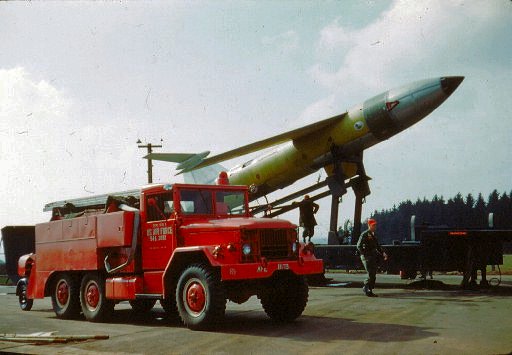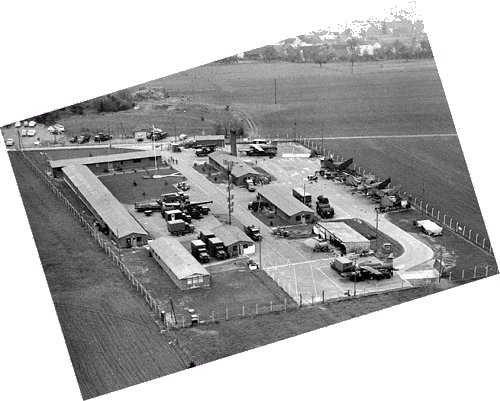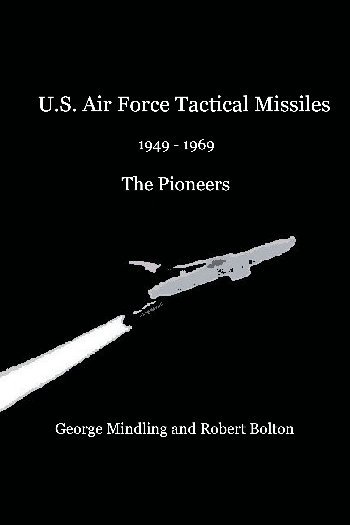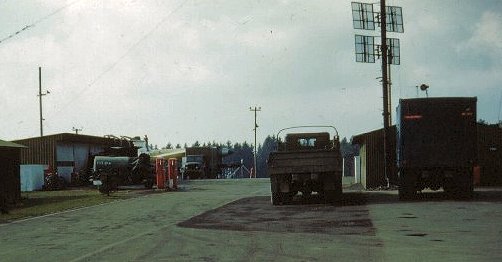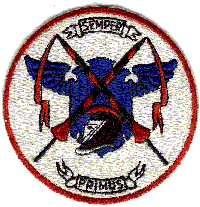 |
U.S. Air Force Tactical Missiles
|
|
Beyond the Web Page... The only book devoted exclusively to the Matador and Mace Tactical Missiles. The book reveals the story from the initial idea that became the first U.S. pilotless bomber, through the politically troubled development of the ever evolving deployment methods of the Matador and Mace Tactical Missiles. It covers the Units, Groups, Squadrons and Wing that fielded the missiles. From the United States test sites, Europe, Asia and North Africa nothing is omitted. All phases of the application of these two missiles by the U.S. Air Force (and West German Luftwaffe) are included, from the first tentative launches of the XSSM-A-1 Matador in January 1949, to the tense alert duty of the Cuban Missile Crisis, and the final launch of a MQM13A in May of 1977. The maintenance, logistics and launch, the men, equipment and tactics are all there. |

|
"U.S. Air Force Tactical Missiles" is an excellent, comprehensive history of a very little-known aspect of the development and operational deployment of American guided missiles in the early days of the Cold War. The title may lead one to believe that the book is a fairly broad outline of tactical missiles developed during that period. But it really covers just one system--the Glenn L. Martin Company's TM-61 "Matador" turbojet-powered cruise missile and its follow-on, the upgraded TM-76 "Mace." "The level of detail in "U.S. Air Force Tactical Missiles" is remarkable. The authors start out with an assessment of the world's first practical, mass-produced cruise missile--the German V-1 ("Vergeltungswaffe Eins," or "Vengeance Weapon 1") "flying bomb" that Hitler used against England and other European targets in World War II. I thought I knew a lot about the V-1, but I learned things I never knew when I read this book. Some of the technical details about its design, construction and method of operation have never, to my knowledge, appeared in print before, at least not in readily accessible form. The authors apply the same level of detail to the story of the design, development, flight testing and overseas deployment of the "Matador" and "Mace," which trace their lineage directly back to the V-1. Much of "U.S. Air Force Tactical Missiles" is based on reminiscences of former "missileers" with first-hand experience in the care and feeding of "Matadors" and "Maces" in the field. As such, it has the flavor of an "oral history" in which people and their experiences play at least as important a role as the technology." "Very little has been written about America's early cruise missiles. As far as I know, "U.S. Air Force Tactical Missiles" is the only available book-length treatment of this relatively obscure subject. An interesting, in-depth and readable volume, "U.S. Air Force Tactical Missiles" deserves a place on the bookshelf of every serious aerospace history buff." Terry Sunday (sundayt@zianet.com)
|
|
Dieses Buch ist ein Muss für alle, die im Rahmen ihres Dienstes bei der U.S. Air Force mit den frühen Marschflugkörpern zu tun hatten, aber auch für deutsche Militärarchäologen, die in der Eifel, im Hunsrück oder im Pfälzer Wald schon über rätselhafte Hinterlassenschaften gestolpert sind. Nach mehr als 40 Jahren wird endlich eine Fülle von Fakten, Informationen und Geschichten zu den zwischen 1954 und 1969 in Deutschland stationierten, mit Automwaffen ausgerüsteten amerikanischen Matador und Mace auf den Tisch gelegt. Ausführlich und lebendig erzählen George Mindling und Bob Bolton von den jungen Missilemen, die im März 1954 erstmals in Bitburg ankamen - noch ganz grün im Gesicht, weil auf dem Atlantik schwerer Sturm geherrscht hatte. Von den T-33-Flugzeugen, die aus Übungsgründen so taten, als wären sie Matador-Flugkörper, über die Startstellungen hinweg in Richtung deutsch-deutsche Grenze donnerten und sich von der Gegenseite nur nicht erwischen lassen durften. Oder von der Kuba-Krise, als die US Air Force Europe auf DEFCON 3 ging und an die Mechaniker in Bitburg Munition für ihre Karabiner ausgegeben wurde. Augenzeugen sagen dazu: "Wir hätten die Vögel auf jeden Fall innerhalb von 15 Minuten in der Luft haben müssen!" Es ist lebendige Militärgeschichte, die nun nicht der Vergessenheit anheimfällt, sondern jedermann zugänglich wird - auch für die ortsansässige Bevölkerung, die heute endlich erfährt, was sich damals in ihrer Nachbarschaft zugetragen hat. Den beiden Autoren gebührt der Dank. Klaus Stark (klaus_stark@t-online.de)
This book is not only a must for all those who served in the U.S. Air Force with the early cruise missiles, but also for German military archeologists who have been puzzling over relics stumbled across in the Eifel, the Hunsrück and the Palatinate Forests. After more than 40 years, we finally have a wealth of facts, information and stories, from 1954 to 1969, of the nuclear equipped American Matador and Mace missiles stationed in Germany placed on the table. With detailed and vivid descriptions, George Mindling and Bob Bolton talk about the young Missilemen who arrived for the first time in March, 1954, in Bitburg - still green in the face, having prevailed the Atlantic crossing in major storm. Of the T-33 aircraft which practiced as if they Matador missiles launched in the direction of German-German border, or from the Cuban missile crisis, when the U.S. Air Force Europe went on DEFCON 3 and was issued ammunition to the mechanics in Bitburg for their rifles. Eyewitnesses say: "We would have to have the birds in the air in any event within 15 minutes!" It is vital military history that is prey to oblivion, but is now accessible to everyone - even for the local population, which today finally learns what happened at that time in their neighborhood. The two authors deserve thanks for saving the history.
Klaus Stark, |

Available Now!, Click Here to Order "U.S. Tactical Missiles 1949-1969 The Pioneers" |
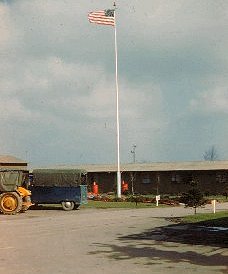 The Adminstration building behind the flag pole, with the officer's quarters and the water filtering system to the left. A U.S. Air Force VW Kombi sits parked alongside a USAF tractor used for site maintenance G. Joseph Snyder (gjsnyder@sbcglobal.net) |
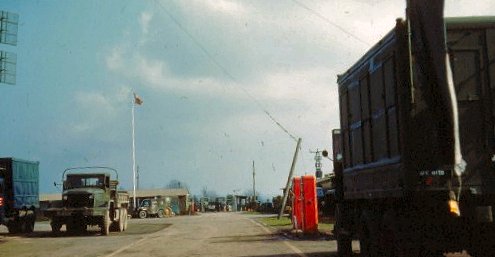 "The upper photo is a view of the main road through the Steinborn Flight "A" Missile Site. in the background in the main gate and to the rightof the main gate is the Air Police Guard Booth. The building in the background, to the left, is the Administration Office and I believe,the Officers Quarters. The large van to the right, behind the gas pumps, is one of the two Armament Vans used to check out andarm the warhead of the TM61-C Matador."
|
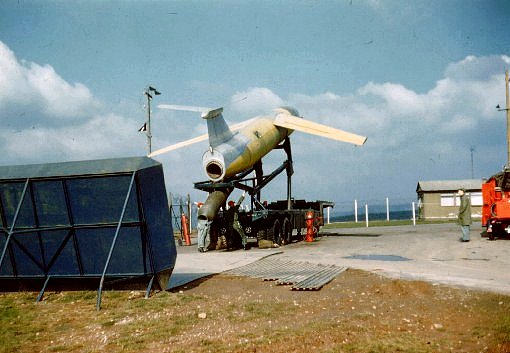 "The blast shield was installed to divert the jet blast to preventdamage to the farmers crops that surrounded the Flight "A" Missile Site." |
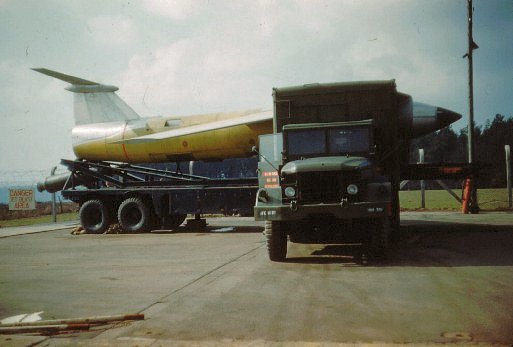 "Armament Van backed up to war head for check out of weapon system. This was on the back launch pad, or Pad 2." |
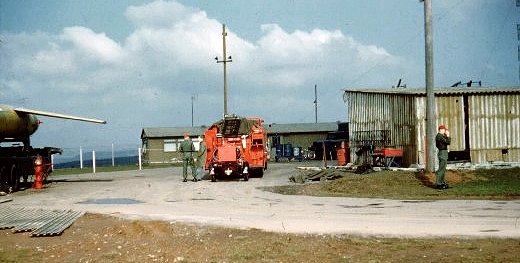 "This is a photograph of the back pad, or pad #2, at Steinborn Launch Site. The building in the background is the entertainment building for the site, which housed a pool table, movie projection room, and of course to the far left of the building, abar. G. Joseph Snyder (gjsnyder@sbcglobal.net) |
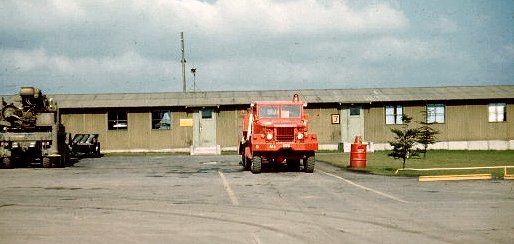 "The barracks for enlisted personnel at Steinborn. ...there were 6 to 8 rooms, each ofwhich held 7 men. This building was to the right as one drove in through the main, and only, gate to the site." |
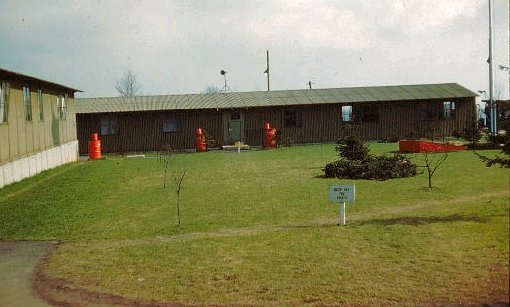 "This is another view of the Administration Building. The Air Police Guard Post is just to the right of the flag pole. The building to the far left is part the enlisted personnel barracks." |
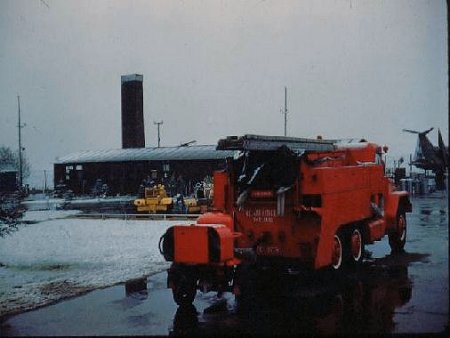 "The building in the background is the mess halland furnace room. In back of the mess hall is the front launch pad, or Pad1. To the right one can see one of the back up missiles, in storage. Looks like a first snow." |
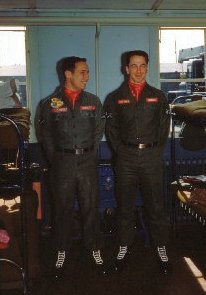 "This was the new look in missile launch crew members." [The 585th TMG Group patch became a requirement and was worn by all 71st Tactical Missile Squadron launch crews until replaced by the 36th Tactical Fighter Wingpatch in 1965. The colors were worn until shutdown in 1969. The correct placement for the patch was later moved to the right breast pocket] The airman on the left is A/2c Antonie A. Kokolis, and on the right, A/1c George Joseph Snyder |
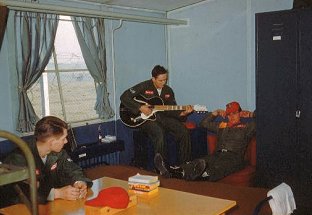 Alert Standby duty could be monotonous at times... ...But time off was never wasted... |
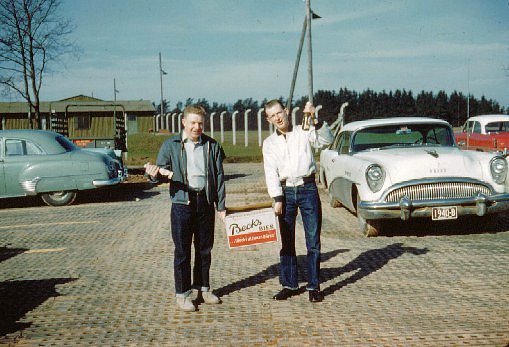 "This photograph was taken in 1960. The color pattern on the Buick's license plate was used in 1960, in 1961 the colorpattern was just the opposite. Note the PSP (Perforated Steel Planking) to keep their vehicles from getting stuck in the winter mud." G. Joseph Snyder (gjsnyder@sbcglobal.net) |
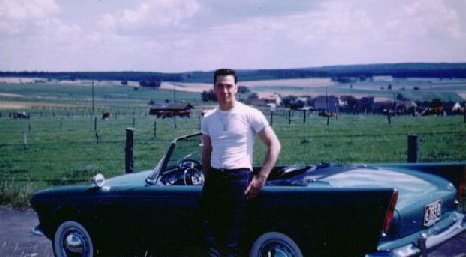 GJ Snyder at Steinborn with his Sunbeam Alpine in 1960 |
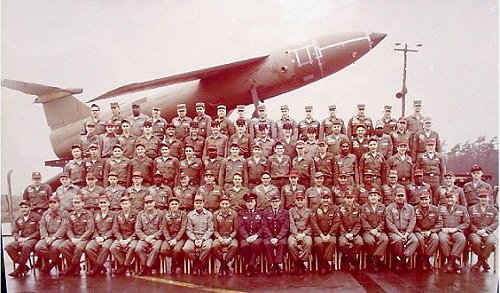 |
This photograph was taken of all personnel who were stationed at Steinborn in 1960, including launch crew members, launch officers, G&C personnel, air police, cooks, everybody on site. |
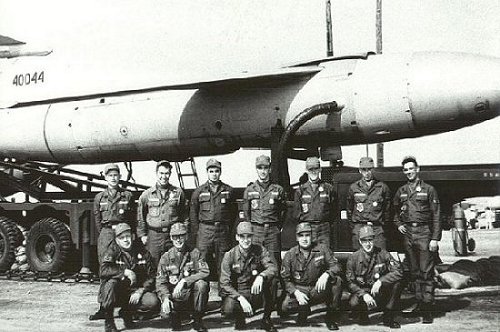 |
The photograph was during our TDY for 19 days toOrlando AFB, for a live practice launch which started on November 12, 1959. We were stationed at SteinbornMissile Site, Flight "A" at the time. I believe that we were Crew 4. Names of those depicted in the photograph are as follows: |
 May 1st, 2007 - The old Steinborn launch site peacefully coexists with a contemporary wind farm Photo by George Mindling (myakka@embarqmail.com) |
Steinborn, Kreis Bitburg, Germany - "A" Pad - 2005 |
|
...The road that one takes to get there from Bitburg, is road B257 out of Bitburg, also called Bitburg Strasse. Go North-East until you get to Steinborn, and then take the second turn off to the left, named "Hauptstrasse". Go straight and "Hauptstrasse" will turn to the right, but you should go straight onto the road named "Bergstrasse" Stay on "Bergstrasse", go up the hill and then turn left at the next intersection. "Bergstrasse" continues to the right, and when you turn left you should be on "Auf der Held" as you go up this street, the old Steinborn Missile Site will be on the right and has trees and bushes growing in the old site... Best Regards, Joseph Snyder |
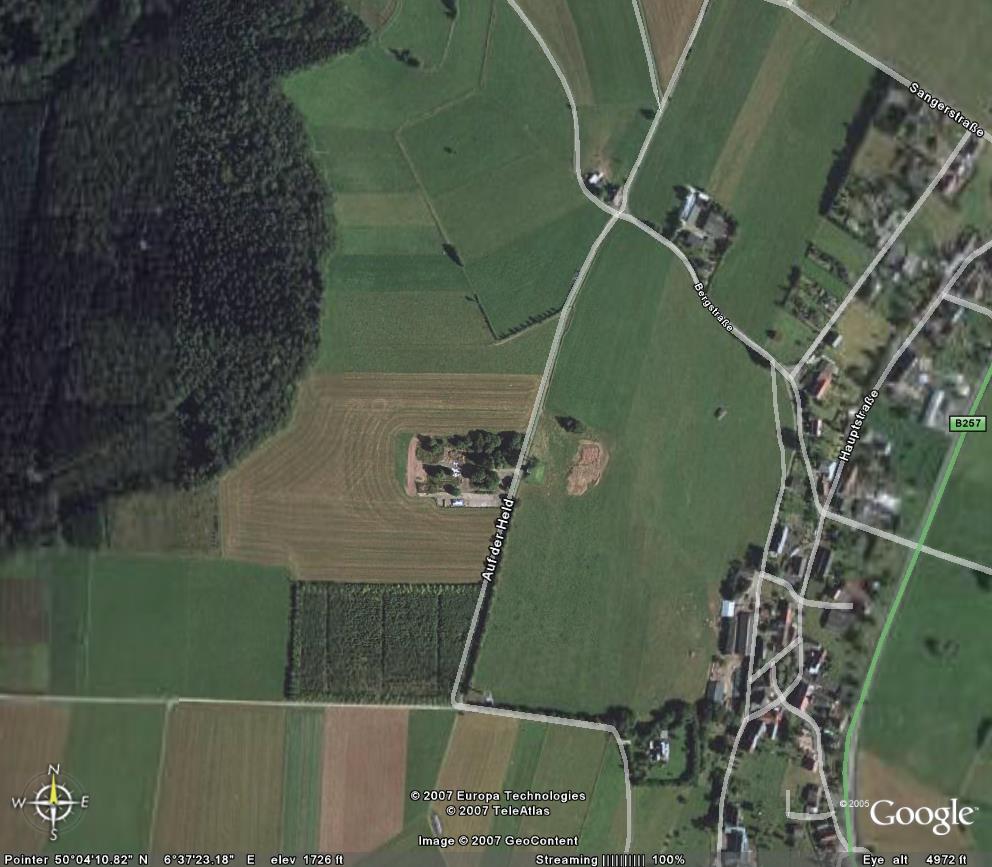 Photo Courtesy of Google Earth |
 Home Page |
[ Sembach Air Base | Hahn Air Base | Bitburg Air Base | 498th TMG| 4504th MTW ]
[ Guidance & Flight Controls | Spotter's Guide | Missile History ]
[ MM-1 Teracruzer | Mace Models & Patches | Contact Us ]
This page is in no way sponsored or endorsed by the United States Air Force. |
All Contributions remain the property of the original owners
All Contributions used with Permission
Web Page Design and Development by
George Mindling - Port Charlotte, Florida
©George Mindling - 2003-2006, 2018 All Rights Reserved
